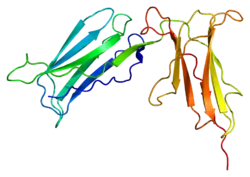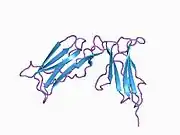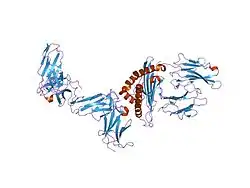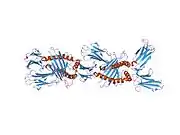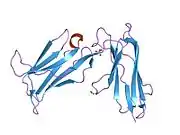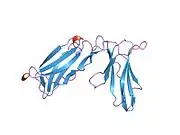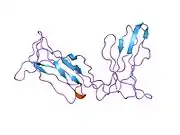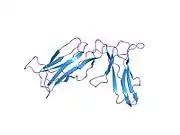KIR2DS4
Killer cell immunoglobulin-like receptor 2DS4 is a protein that in humans is encoded by the KIR2DS4 gene.[3][4][5]
Killer cell immunoglobulin-like receptors (KIRs) are transmembrane glycoproteins expressed by natural killer cells and subsets of T cells. The KIR genes are polymorphic and highly homologous and they are found in a cluster on chromosome 19q13.4 within the 1 Mb leukocyte receptor complex (LRC). The gene content of the KIR gene cluster varies among haplotypes, although several "framework" genes are found in all haplotypes (KIR3DL3, KIR3DP1, KIR3DL4, KIR3DL2). The KIR proteins are classified by the number of extracellular immunoglobulin domains (2D or 3D) and by whether they have a long (L) or short (S) cytoplasmic domain. KIR proteins with the long cytoplasmic domain transduce inhibitory signals upon ligand binding via an immune tyrosine-based inhibitory motif (ITIM), while KIR proteins with the short cytoplasmic domain lack the ITIM motif and instead associate with the TYRO protein tyrosine kinase binding protein to transduce activating signals. The ligands for several KIR proteins are subsets of HLA class I molecules; thus, KIR proteins are thought to play an important role in regulation of the immune response.[5]
See also
References
- ENSG00000274406, ENSG00000277078, ENSG00000274807, ENSG00000275353, ENSG00000275731, ENSG00000273526, ENSG00000275351, ENSG00000274921, ENSG00000277345, ENSG00000276885, ENSG00000284408, ENSG00000274957, ENSG00000276154, ENSG00000284307, ENSG00000283779, ENSG00000274324, ENSG00000221957, ENSG00000274714, ENSG00000274533, ENSG00000276209, ENSG00000276634, ENSG00000276465, ENSG00000274947, ENSG00000283727, ENSG00000283846, ENSG00000276395, ENSG00000275938, ENSG00000284244, ENSG00000284264, ENSG00000283870, ENSG00000283882, ENSG00000276254 GRCh38: Ensembl release 89: ENSG00000273931, ENSG00000274406, ENSG00000277078, ENSG00000274807, ENSG00000275353, ENSG00000275731, ENSG00000273526, ENSG00000275351, ENSG00000274921, ENSG00000277345, ENSG00000276885, ENSG00000284408, ENSG00000274957, ENSG00000276154, ENSG00000284307, ENSG00000283779, ENSG00000274324, ENSG00000221957, ENSG00000274714, ENSG00000274533, ENSG00000276209, ENSG00000276634, ENSG00000276465, ENSG00000274947, ENSG00000283727, ENSG00000283846, ENSG00000276395, ENSG00000275938, ENSG00000284244, ENSG00000284264, ENSG00000283870, ENSG00000283882, ENSG00000276254 - Ensembl, May 2017
- "Human PubMed Reference:". National Center for Biotechnology Information, U.S. National Library of Medicine.
- Bottino C, Sivori S, Vitale M, Cantoni C, Falco M, Pende D, Morelli L, Augugliaro R, Semenzato G, Biassoni R, Moretta L, Moretta A (Oct 1996). "A novel surface molecule homologous to the p58/p50 family of receptors is selectively expressed on a subset of human natural killer cells and induces both triggering of cell functions and proliferation". Eur J Immunol. 26 (8): 1816–24. doi:10.1002/eji.1830260823. PMID 8765026. S2CID 23526107.
- Wagtmann N, Biassoni R, Cantoni C, Verdiani S, Malnati MS, Vitale M, Bottino C, Moretta L, Moretta A, Long EO (Jun 1995). "Molecular clones of the p58 NK cell receptor reveal immunoglobulin-related molecules with diversity in both the extra- and intracellular domains". Immunity. 2 (5): 439–49. doi:10.1016/1074-7613(95)90025-X. PMID 7749980.
- "Entrez Gene: KIR2DS4 killer cell immunoglobulin-like receptor, two domains, short cytoplasmic tail, 4".
Further reading
- Döhring C, Samaridis J, Colonna M (1996). "Alternatively spliced forms of human killer inhibitory receptors". Immunogenetics. 44 (3): 227–30. doi:10.1007/BF02602590. PMID 8662091. S2CID 38478576.
- Kim J, Chwae YJ, Kim MY, et al. (1997). "Molecular basis of HLA-C recognition by p58 natural killer cell inhibitory receptors". J. Immunol. 159 (8): 3875–82. doi:10.4049/jimmunol.159.8.3875. PMID 9378975. S2CID 21878260.
- Campbell KS, Cella M, Carretero M, et al. (1998). "Signaling through human killer cell activating receptors triggers tyrosine phosphorylation of an associated protein complex". Eur. J. Immunol. 28 (2): 599–609. doi:10.1002/(SICI)1521-4141(199802)28:02<599::AID-IMMU599>3.0.CO;2-F. PMID 9521070. S2CID 20705491.
- Chwae YJ, Cho SE, Kim SJ, Kim J (1999). "Diversity of the repertoire of p58 killer cell inhibitory receptors in a single individual". Immunol. Lett. 68 (2–3): 267–74. doi:10.1016/S0165-2478(99)00062-0. PMID 10424431.
- Fan QR, Long EO, Wiley DC (2000). "Cobalt-mediated dimerization of the human natural killer cell inhibitory receptor". J. Biol. Chem. 275 (31): 23700–6. doi:10.1074/jbc.M003318200. PMID 10816589.
- Rajalingam R, Gardiner CM, Canavez F, et al. (2001). "Identification of seventeen novel KIR variants: fourteen of them from two non-Caucasian donors". Tissue Antigens. 57 (1): 22–31. doi:10.1034/j.1399-0039.2001.057001022.x. PMID 11169255.
- Katz G, Markel G, Mizrahi S, et al. (2001). "Recognition of HLA-Cw4 but not HLA-Cw6 by the NK cell receptor killer cell Ig-like receptor two-domain short tail number 4". J. Immunol. 166 (12): 7260–7. doi:10.4049/jimmunol.166.12.7260. PMID 11390475.
- Hsu KC, Liu XR, Selvakumar A, et al. (2002). "Killer Ig-like receptor haplotype analysis by gene content: evidence for genomic diversity with a minimum of six basic framework haplotypes, each with multiple subsets". J. Immunol. 169 (9): 5118–29. doi:10.4049/jimmunol.169.9.5118. PMID 12391228.
- Maxwell LD, Wallace A, Middleton D, Curran MD (2003). "A common KIR2DS4 deletion variant in the human that predicts a soluble KIR molecule analogous to the KIR1D molecule observed in the rhesus monkey". Tissue Antigens. 60 (3): 254–8. doi:10.1034/j.1399-0039.2002.600307.x. PMID 12445308.
- Strausberg RL, Feingold EA, Grouse LH, et al. (2003). "Generation and initial analysis of more than 15,000 full-length human and mouse cDNA sequences". Proc. Natl. Acad. Sci. U.S.A. 99 (26): 16899–903. Bibcode:2002PNAS...9916899M. doi:10.1073/pnas.242603899. PMC 139241. PMID 12477932.
- Artavanis-Tsakonas K, Eleme K, McQueen KL, et al. (2004). "Activation of a subset of human NK cells upon contact with Plasmodium falciparum-infected erythrocytes". J. Immunol. 171 (10): 5396–405. doi:10.4049/jimmunol.171.10.5396. PMID 14607943.
- Maxwell LD, Williams F, Gilmore P, et al. (2005). "Investigation of killer cell immunoglobulin-like receptor gene diversity: II. KIR2DS4". Hum. Immunol. 65 (6): 613–21. doi:10.1016/j.humimm.2004.02.028. PMID 15219381.
- Katz G, Gazit R, Arnon TI, et al. (2004). "MHC class I-independent recognition of NK-activating receptor KIR2DS4". J. Immunol. 173 (3): 1819–25. doi:10.4049/jimmunol.173.3.1819. PMID 15265913.
- Yen JH, Lin CH, Tsai WC, et al. (2006). "Killer cell immunoglobulin-like receptor gene's repertoire in rheumatoid arthritis". Scand. J. Rheumatol. 35 (2): 124–7. doi:10.1080/03009740500381252. PMID 16641046. S2CID 29445959.
This article incorporates text from the United States National Library of Medicine, which is in the public domain.
